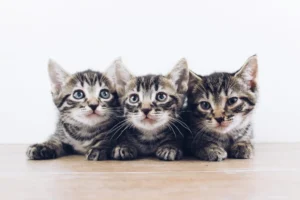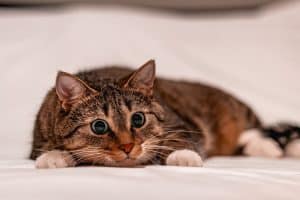Cats are mysterious creatures with many quirky behaviors that leave us scratching our heads in confusion. One such behavior that often leaves cat owners perplexed is why cats sit on balls and wiggle. It’s a sight that is both amusing and puzzling, but there are reasons behind this seemingly random action.
Cats have a natural instinct to stalk and hunt prey, and sitting on a ball and wiggling mimics this behavior. It allows them to practice their hunting skills and satisfy their predatory instincts in a safe and playful manner.
The Appeal of Balls to Cats
Cats have an innate attraction to balls for a variety of reasons. The size and shape of balls mimic small prey animals, triggering a cat’s hunting instincts. The texture of balls can also be intriguing to cats, providing a different tactile experience compared to other objects.
Additionally, balls are often lightweight and easy to bat around, providing entertainment and mental stimulation for cats. This interactive play can help satisfy a cat’s natural predatory drive and keep them engaged and active.
Moreover, the rolling motion of a ball can mimic the unpredictable movements of prey, making it an exciting target for cats to chase and pounce on. The combination of these factors makes balls an irresistible and engaging toy for our feline friends.
For further enrichment, consider incorporating crinkle balls or bouncy balls to provide a variety of textures and movements that will appeal to your cat’s senses and keep them entertained.
The Wiggling Behavior Explained
When a cat sits on a ball and wiggles, it’s not just a random behavior – there’s a purpose behind it. This wiggling motion is often linked to a cat’s hunting instincts and predatory nature. As cats observe their surroundings, they instinctually wiggle to mimic the movement of prey and prepare for a potential pounce.
By wiggling on the ball, cats are practicing their hunting techniques, honing their coordination, and sharpening their reflexes. This behavior allows them to stay agile and ready to spring into action when the time comes to catch their “prey.”
Next time you see your cat wiggling on a ball, remember that it’s not just play – it’s a way for them to stay sharp and in tune with their natural hunting instincts. Encouraging this behavior with interactive play sessions can help satisfy your cat’s primal urges and provide them with mental and physical stimulation.
For a unique twist, try incorporating a cat tunnel into your play sessions, creating an environment that simulates hunting in the wild and engages your cat’s natural instincts even further.
Engaging in Play and Exercise
Cats are natural hunters and need mental and physical stimulation to stay healthy and happy. When they sit on a ball and wiggle, it’s like they’re simulating catching prey. This playful behavior allows them to engage their instincts and get some exercise at the same time. So, next time you see your furry friend wiggling on a ball, know that they’re just having a blast and staying active!
Benefits of Play and Exercise for Cats:
- Mental Stimulation: Playing helps cats stay sharp and avoid boredom.
- Physical Exercise: Wiggling on a ball helps them stay agile and healthy.
- Stress Relief: Playtime can reduce anxiety and keep your cat relaxed.
- Bonding Opportunity: Spending time playing with your cat can strengthen your bond.
Bonding and Social Interaction
Cats may sit on balls and wiggle not just for fun but also as a way to connect with their human companions or other pets. This behavior can be a form of communication, expressing their desire for attention or playtime. By wiggling on a ball, cats are inviting you to join in the fun and strengthen your relationship. So, embrace these playful moments and bond with your feline friend!
When your cat wiggles on a ball, it’s their way of initiating interaction and showing affection. By responding positively and engaging in play, you’re building trust and creating special memories together. So, don’t miss out on these opportunities to connect with your furry companion and make them feel loved and valued.
Providing Enrichment and Entertainment
Discover how balls and toys can enrich a cat’s environment and provide endless entertainment, keeping them mentally and physically stimulated.
Cats are natural hunters, and providing them with balls to chase and wiggle on taps into that instinctual behavior. These toys offer mental stimulation as your cat pounces, swats, and wiggles, mimicking the thrill of a successful hunt. This enrichment helps prevent boredom, keeping your feline friend engaged and satisfied.
Incorporating balls into your cat’s environment can also encourage physical activity. As they chase, bat, and wiggle on the balls, they engage their muscles, promoting exercise and overall health. It’s a fun and interactive way for your cat to stay active, which is crucial for their well-being.
By offering balls and interactive toys, you create a dynamic environment that prevents your cat from getting bored. Regularly rotating toys can keep them engaged and provide new challenges, preventing them from getting tired of the same old routine. This variety keeps their minds sharp and their bodies active, leading to a happy and healthy pet.
Tip: Consider different textures and sizes of balls to offer a variety of experiences for your cat. Some may prefer soft, squishy balls, while others enjoy harder, bouncier ones. Experiment to see what your cat enjoys most!
Preventing Boredom and Behavioral Issues
Learn how interactive play and engaging activities like sitting on balls and wiggling can prevent boredom and alleviate common behavioral problems in cats.
Boredom can lead to a range of behavioral issues in cats, including excessive meowing, scratching, and aggression. By incorporating balls and interactive play into their routine, you provide mental and physical stimulation that can prevent these problems from arising. Playing with your cat on balls and engaging in interactive activities helps channel their energy in a positive way, reducing the likelihood of destructive behaviors.
Sitting on balls and wiggling can be a form of self-play for cats, allowing them to entertain themselves when you’re not available. This independent playtime can help alleviate boredom and provide a healthy outlet for their energy. It’s a natural way for cats to stay occupied and content when they’re alone.
Interactive play also strengthens the bond between you and your cat. By actively engaging in playtime with balls, you build trust and create positive experiences that enhance your relationship. It’s a chance to connect with your pet in a fun and meaningful way, benefiting both of you.
Tip: Rotate your cat’s toys regularly to keep them engaged and interested. Introducing new toys or switching up games can prevent boredom and ensure your cat stays entertained.
Fun Facts About Cats and Their Behavior
Did you know that cats sitting on balls and wiggling is a common behavior among our feline friends? This quirky action may seem amusing, but it actually serves a purpose. When cats sit on balls and wiggle, they are engaging in a form of predatory behavior. The movement mimics the actions they would take when hunting prey in the wild, helping them to sharpen their hunting skills and instincts even in a domestic setting.
Cats have a strong predatory drive, and engaging in playful behaviors like sitting on balls and wiggling allows them to satisfy this natural instinct. It also provides them with mental stimulation and physical exercise, keeping them entertained and active. So, the next time you see your cat sitting on a ball and wiggling, know that they are simply letting out their inner hunter in a fun and harmless way.
Here are some other fascinating facts about cats and their behaviors:
- Cats have a unique form of communication through body language, vocalizations, and scent marking.
- Cats are crepuscular animals, meaning they are most active during dawn and dusk.
- Cats have a strong sense of territory and may display territorial behaviors like scratching furniture or rubbing their scent on surfaces.
- Cats knead with their paws to mark their territory with scent glands and to show contentment.
- Cats groom themselves to regulate body temperature, relieve stress, and maintain cleanliness.
These fun facts shed light on the complex and intriguing world of our feline companions, showing just how unique and fascinating they truly are. Whether they are sitting on balls and wiggling or exhibiting other intriguing behaviors, cats never cease to surprise and entertain us with their quirky antics.
Alex, a passionate animal lover, has experience in training and understanding animal behavior. As a proud pet parent to two dogs and three cats, he founded AnimalReport.net to share insights from animal experts and expand his knowledge of the animal kingdom.









